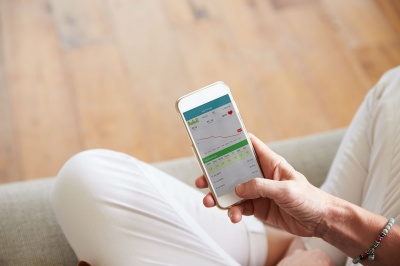
4 key digital trends in diabetes care

- Healthcare
- Pharmaceutical
The diabetes epidemic continues to grow in the UK. With a growing diabetic patient population, health care professionals (HCPs) are faced with an overwhelming backlog of patient needs, with the provider-to-patient ratio growing more disparate as time goes on. On average, a diabetes patient in the UK spends only 20 minutes with an HCP per year and must be almost entirely self-reliant in managing their condition.
However, technological advancements have made great bounds in alleviating the pressures on both patients and HCPs in recent years. With the arrival of insulin pumps, dedicated diabetes mobile apps, data analysis and remote monitoring, it is becoming easier than ever for patients to self-manage and for HCPs to have a more accurate overview of a patients’ condition.
As the role of digital within diabetes management continues to expand, we’ll be seeing more and more digital solutions that address the key needs of diabetes patients and HCPs alike. We take a look at 4 key digital trends in diabetes care.
Definitions: Type 1 vs. Type 2 Diabetes
Type 1 Diabetes
Type 1 diabetes is a genetic condition where the immune system attacks cells that produce insulin. This means patients are unable to produce enough insulin to regulate blood glucose resulting in a need to inject insulin daily to maintain blood sugar levels.
Blood sugar needs to be kept at just the right level — not too high or too low. Type 1 diabetics are caught in a perpetual balancing act to ensure the correct dosage of insulin to stay within healthy levels.
Type 2 Diabetes
Type 2 diabetes also has a genetic component but can be brought on and influenced by lifestyle factors. Similarly to type 1 diabetics, type 2 diabetes patients are unable to produce enough insulin to regulate blood sugar.
Type 2 diabetics use insulin, oral medications and lifestyle changes to maintain healthy blood glucose levels.
4 digital trends in diabetes care
Clinically approved mobile apps for everyday management and logging
For those who have to juggle managing their health conditions amongst the stresses of day-to-day lives, health apps can be a great way to help monitor and manage conditions. From tracking medication use, to monitoring diet and exercise, there are a variety of health apps that can help make managing conditions easier.
Although there are numerous independent apps for managing and logging blood glucose (a key factor in diabetes management) there are also a number of clinically approved mobile apps that can be prescribed or recommended by HCPs to help patients track the management of both type 1 and type 2 diabetes. Examples of these include MySugr and Mumoactive.
Until relatively recently, apps designed to support diabetes care in patients were difficult to integrate with existing diabetes technology — such as continuous glucose monitors, smart pens, and insulin pumps. This meant that patients would need to refer to three different systems to calculate glucose, inject insulin, and then log all information.
These newer models are now starting to integrate more seamlessly with mobile technology and independent apps, making it much easier for patients to log blood glucose and calculate insulin dosages.
Smart pens and AI-assisted pumps
Over the last few years, we have seen an increase in uptake in “smart pens” and AI-assisted insulin pumps. There are many benefits in using smart pens but ultimately they help to provide a more accurate way to administer metered dosing for insulin.
Smart insulin pens help collect, store and transmit insulin dosing data. This can be easily shared between patients and their healthcare team. This enables better medication adherence and more specific advice on care for healthcare professionals.
AI-assisted insulin pumps help support diabetics by analysing glucose levels alongside insulin dosage ratios to automatically calculate insulin dosages. They are even able to predict high or low blood sugar events before they happen and, in the event of low blood sugars, halt the flow of insulin. As the technology develops, it gets closer to mimicking the way the body naturally delivers and regulates insulin.
Example smart pens that are currently available include NovoPen6 and NovoPen Echo Plus and the InPen.
Cloud-based data management for glucose patterns
A perpetual challenge with diabetes self-management is the limited time patients have with their HCPs. Historically, an HBA1c blood test is taken during a diabetes review with an HCP, and gives an ‘average’ of blood glucose levels over a certain period of time. The HCP can use this to assess whether a patient is likely to develop complications due to high blood sugars.
However, this only renders a partial picture of the overall glucose patterns in a patient in one given time period and makes it difficult for an HCP to advise on more specific issues in patterns. A diabetes patient may frequently experience high blood sugar levels at a particular time of day due to stress or tiredness, but this is not reflected in the HBA1c.
Cloud-based data management for glucose levels helps alleviate this strain. Apps such as MySugr, Freestyle LibreLink and many others that log blood sugar levels store a repository of sugar levels and are able to determine specific patterns graphically, meaning that both patient and HCP can detect and treat these patterns before they cause further damage.
It also means that a healthcare team is able to remotely access and monitor a patient's glucose levels without the need for face-to-face meetings, alleviating some of the pressure of the diabetes backlog, and freeing up patients’ time.
Wider adoption and future focus
As the digital and technological offerings for diabetes patients continue to evolve, there is a growing focus on making this life-changing technology more accessible across economic and social divides.
Technology such as smart pens, insulin pumps and continuous glucose monitoring is already available on the NHS, however many patients face a long waiting list to be able to partake.
With wider adoption, the future of digital diabetes care will focus more on younger generations and how digital offerings can be more personalised to the specific needs of the Gen-Z diabetic population.
As an example, Dexcom, a continuous glucose monitoring device, now translates glucose data into 30-second snippets that are more digestible and engaging than the historical ‘graph’ or ‘log’ view, and helps a younger user base detect and understand their condition to aid in self-management.
From the not-so-distant past reality of our grandparents having to go to their doctor to get blood taken and find out their blood glucose levels four days later, technology has truly revolutionised the way diabetes is treated and managed today.
Diabetic patients are now able to scan a chip on their arm into their mobile phones, which is able to indicate, within seconds, what their blood sugars are and how much insulin to inject. Technology has empowered patients to take control of their condition, rather than letting it control them.
Healthcare professionals working within diabetes care are able to remotely view glucose patterns and gather more patient data then ever before, enabling them to give better, more informed advice to their patients.
It is certainly the best time in history to be diabetic, as the integration of digital offerings and diabetes technology evolves even further than we could have imagined.
On World Diabetes Day 2021, we’re feeling hopeful about the future of diabetes care and the transformational power of digital within it.
Want more on digital health?


5 lessons for digital healthcare teams
- Healthcare

The importance of accessible and inclusive design for digital health and pharma products
- Healthcare
- Pharmaceutical
- Design